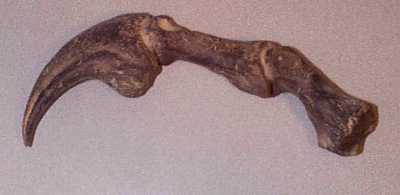
The shell of Orthoceras is shaped like a slowly tapering cylindrical cone and is made up of closely spaced concavo-convex chambers, joined together by a centrally place tube called the siphuncle. Orthoceras was an active swimmer, with the shell positioned horizontally in the water. It scavenged and preyed on small aquatic animals. The Orthoceras shown is from Morocco, North Africa, and dates from the Middle Ordovician Period, 400 million years ago. This display weighs thirty five pounds.
Turritella

Turritella is a very high, slender shell of many whorls. It's age is from the Triassic Period to Recent, and is widespread in North America. Turritella, the turret shell, is one of the most common Mesozoic and Tertiary fossil found in North America. The present Turritella lives in sediment, and filters fine particles of food from the water. The specimen shown is from the Miocene Period, Burdigalien Formation, at Bordeaux, France.
Allosaur fragilis Finger & Claw

Allosaurs belong the the family of dinosaurs known as theropods. They were the largest carnivores of the late Jurassic. Their remains are some of the most complete of known theropod dinosaurs. Allosaurus was first discovered in 1869 in Grand County, Colorado. Large adults of the species could attain a length of over 30 feet and heights of 15 to 18 feet. The claws of Allosaurus do not have a sharp edge on the underside which indicated that they were used principally for grasping (like hawks and owls) rather than cutting.
Mammoth Molar

This tooth is probably from south central Nebraska, most likely from a gravel pit in the Grand Island, Nebraska area. I purchased the tooth from an antique store in Minden, Nebraska. The tooth is 6.5 inches high, 10 inches long and weighs 8.5 pounds.
Mastodon Molar

This molar has been damaged, but with a little glue and patience, its in one piece again. This was found in the Withlacoochee River, Florida. It lived during the Pleistocene Period, maybe as recent as 8,000 years ago.